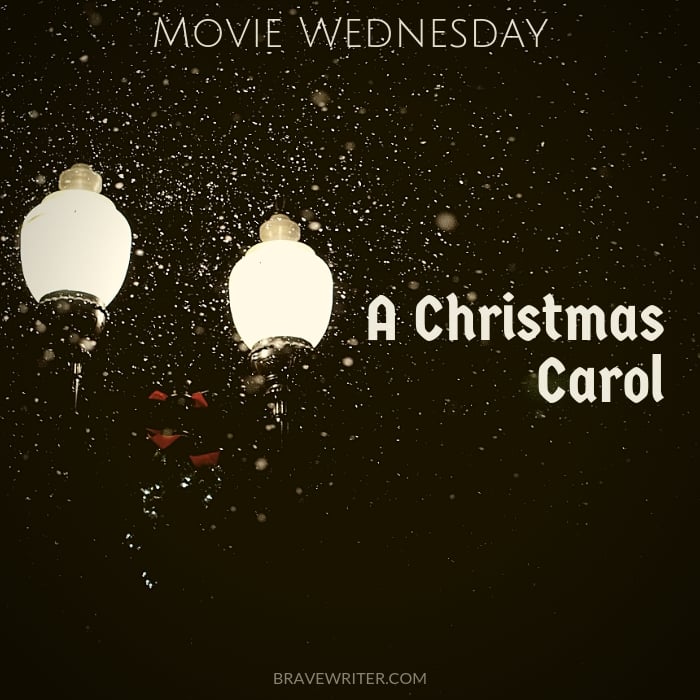Movie Wednesday: A Christmas Carol

by Brave Writer alum, Amy Frantz
Ebenezer Scrooge is a selfish miser who believes Christmas and good will towards his fellow man are all “humbug.” But one Christmas Eve night, Scrooge is visited by the ghost of his old business partner, Marley, who warns Scrooge that he will be visited by three more spirits and if Scrooge does not heed what they show him then he will be doomed like Marley to wander alone and in chains as a ghost. At first Scrooge dismisses Marley’s apparition as the product of indigestion, but at the stroke of one o’clock the first spirit appears to him.
The spirits of Christmas Past, Present, and Yet to Come all manifest to Scrooge, showing him visions of his youth, the squalor and suffering of the poor which he has ignored in the present, and his fate “yet to come” if Scrooge remains as he is. But can Ebenezer Scrooge mend his ways and change his heart in time to prevent what he sees or will he be doomed to his fate?
[This post contains Amazon affiliate links. When you click on those links to make purchases,
Brave Writer receives compensation at no extra cost to you. Thank you!]
A Christmas Carol. In Prose. Being a Ghost Story of Christmas, or as it is more commonly known A Christmas Carol, is a novella by Charles Dickens. Published in 1843, it has never been out of print since publication, and is has been so oft adapted and performed that it remains a holiday staple to this day.
One of those many adaptations is the British-American film released in 1984 and starring George C. Scott as the infamous Scrooge. It was filmed on location in Schrewsbury, Shropshire in England.
Ebenezer Scrooge is famous for his uttering of the phrase, “Bah! Humbug!” So much so that it has come to be almost exclusively linked to him in the public consciousness and some people don’t actually know what the word “humbug” means other than being something said by this iconic character. The word humbug refers to a trick or something which is false or deceptive. So, when Scrooge calls Christmas “a humbug,” he means that it is a sham (in his opinion, of course).
Discussion Questions
- Do you think the apparitions that appear to Scrooge are supposed to be real or are they simply the product of a guilty conscience? Explain your answer.
- Towards the end of the film, Scrooge admits that he has spoken too quickly on matters which he gave “no great thought.” What do you think the story is trying to say about “thinking before you speak” and why it matters?
- After being horrified by the visions of his future shown him by the last spirit, Scrooge promises that from now on he will “live in the past, present, and future.” What do you think he means by that?
- Mr. Cratchit carrying Tiny Tim on his shoulder is an iconic image from A Christmas Carol and is often depicted on book covers of the story. What other famous images from the story can you think of and which is your favorite?
Additional Resources
- Informative website: The Charles Dickens Page.
- A Christmas Carol is one of the stories covered in our Boomerang mechanics and literature program. Get the Boomerang guide here.
Learn language arts with the Boomerang program!
The Boomerang is a digital downloadable product that features copywork and dictation passages from a specific read aloud novel. It is geared toward 8th to 10th graders (ages 12—advanced, 13-15) and is the indispensable tool for Brave Writer parents who want to teach language arts in a natural, literature-bathed context.
Amy Frantz is a Brave Writer alum. When not over-analyzing Star Wars, she has been known to have her nose stuck in a book by Dickens.

















